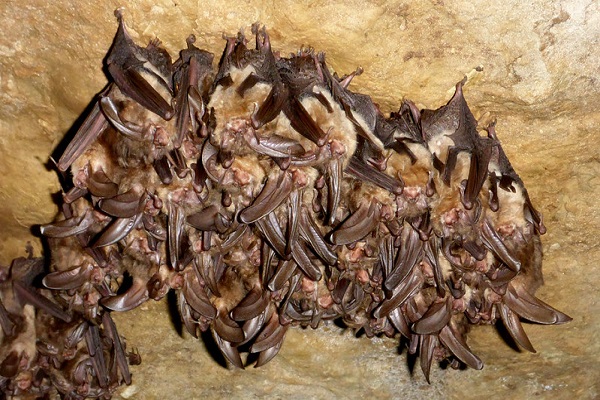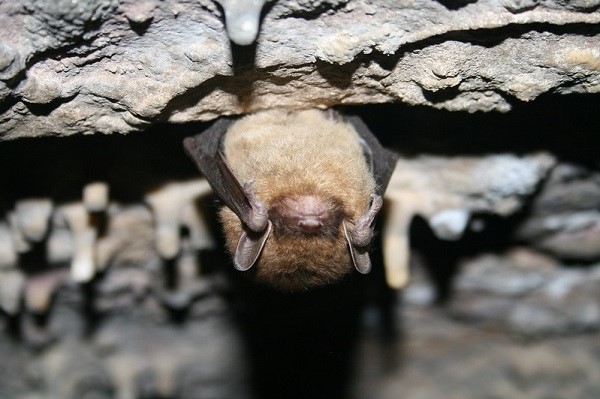
- Brian Moss (President)
- AAAC Wildlife Removal
11/28/2022 Total words : 1611
Predators of Bats
Bats are classic scary movie material. It's easy to think of them as "predators", but have you ever considered that they might be the prey? Despite this popular reputation, bats are actually incredibly important to our ecosystems. More than just creatures of the night, these animals play vital roles in controlling insect populations and pollinating flowers and fruits. In short, they're pretty darn amazing. Unfortunately, all this goodwill doesn't stop bats from having predators of their own. So who or what exactly is out there snacking on these nocturnal creatures? Let's take a look. What Animals Eat Bats? There are many, many animals that enjoy a good bat meal. In fact, you might be surprised to learn that some of the animals on this list are your common, everyday critters. Bats' predators range from domestic animals to a number of wildlife species. Here's a look at some of the animals that eat bats: Cats Aha... these adorable yet conniving little pets. It's no secret that cats love to hunt, and bats are definitely on their menu. Domestic cats, as well as larger felines like bobcats and cougars, will readily snatch up a bat if they get the chance. Bats are nocturnal mammals, so they like hiding in places where it's dark during the day. It can be your attics, porch roofs, chimneys, cable vents, and other small nooks and crannies. Unfortunately for them, this often puts them in close proximity to our furry friends napping spots. And when a bat wanders into these areas, well... let's just say the poor thing doesn't stand a chance. Owls Owls are also nocturnal animals- creatures that are awake at night and sleeping during the day. They hunt alone or in pairs using their sharp claws and beaks to kill their prey. They have large eyes, which help them see in the dark. And their ears are asymmetrical, which means that they can pinpoint the location of their prey by sound. Owls are common bat predators. There are many owl species, and each specializes in hunting different prey. The most well-known bat predators among them are the great horned owl (Bubo virginianus), tawny owls (Strix aluco), and barn owls (Tyto alba). But, what makes bats a staple in their diets? Well, for one thing, bats are relatively easy to catch. They're not particularly fast or agile, so an owl can easily swoop down and snatch one out of the air. Owls also have a very sharp sense of hearing. They can hear sounds that are too faint for humans to hear. And because bats tend to make a lot of noise when they fly, it's easy for owls to spot and hunt them down. Another reason is that bats usually roost in groups. Bats flock in caves, trees, rock crevices, and other dark places. So, when an owl preys on a bat, it's often able to catch more than one. Peregrine Falcons Peregrine falcons are large birds of prey, that have long, sharp talons and a hooked beak. They have long and thin wings that help them fly fast and dive quickly. Peregrine falcons are also known for being on of the fastest animals in the world. They can fly close 200 miles per hour! They use their speed to dive down on their prey and catch it mid-air. So, bats don't really stand a chance against these predators. Peregrine falcons usually eat small birds, but they will also eat bats. In fact, bats make up a large part of their diet in some areas. Hawks Hawks are also birds of prey. They are smaller than falcons, but they are still very fast and agile flyers. They have sharp eyesight and can see their prey from far away. There are many different species of hawks, and each specializes in hunting different types of prey. However, some of the more common bat-eating hawks are Cooper's hawk (Accipiter cooperii) and the sharp-shinned hawk (Accipiter striatus). There are also bat hawks (Macheiramphus alcinus) , which are a type of hawk that specializes in hunting bats. These hawks are found in Central and South America. They have long, curved talons that help them grip their prey as well as large eyes that help them see in the dark. These hawks consume almost nothing else but bats. Hawks hunt by flying high above their prey and then diving down on it. They use their sharp claws and beak to kill their prey. In general, all hawks consume bats. However, most hawk species' primary food sources remain reptiles (e.g., lizards), insects, rodents, and other small mammals. Snakes It's no secret that snakes eat bats too. You know they're already infamous for eating literally anything, no matter how big it may seem. So, it's only natural that they would want to snack on some bats every now and then. Snakes would often hang on trees or cave roofs and strike when a bat flew close by. Although snakes do not have ears to hear, they are very sensitive to sound-induced vibrations. They use this sense to strike at prey, and it is especially useful for detecting the fluttering of wings from a distance. This is how they're able to find and eat bats even though the creatures are nocturnal. Crocodile Can you imagine that these water-loving animals eat bats? Yes, you're not reading this wrong! The crocodile is the second reptile on our list. They are semi-aquatic organisms commonly found in the tropical regions of Australia, Asia, Africa, and America. Crocodiles are enormous, terrifying creatures. Their average size ranges from 17 to 23 feet long, and they can weigh over 2000 pounds. Knowing this, aren't you wondering how these heavy mammals get to eat bats? Or how these bats get into a crocodile's mouth in the first place? Well, turns out that bats, like the flying fox bats of Australia, often dip or drink water from lakes, rivers, and ponds where crocodiles also reside. The crocodiles lie in wait and pounce on the unsuspecting bats. River banks serve as the primary water source for bats, so it's no surprise that they would end up as crocodiles' prey. Bats also hunt insects in bodies of water, so this gives crocodiles another chance to snatch them. Arachnids and Centipedes Arachnids are a class of jointed-legged invertebrate animals. They are characterized by having two body segments: the cephalothorax (the fused head and chest) and the abdomen. Arachnids include spiders, daddy longlegs, scorpions, mites, and ticks. These creatures hunt by spinning webs or building traps to capture their prey. Spiders Can you imagine an organism as small as spiders eating creatures as big as bats? Yes, it happens. We know spiders for their web-spinning abilities which is how bats and other organisms fall prey to these 8-legged arachnids. The sticky and thick web made of spider silk makes it possible for the spider to immobilize their prey. Spiders such as tarantulas, orb-weavers, and huntsman spiders are large enough and know to prey upon bats. They will spin a web and wait for their prey to get stuck into it. Once their prey becomes stuck in the web, the spider will come and wrap it up in webbing. The spider will then inject venom to kill it. Centipedes Centipedes are predators that hunt on the ground and crawl in caves where bats live. Centipedes primarily exist in caves and forests. This is where they can eat roosting, sleeping, or hibernating bats. Centipedes are long and thin, so they can easily sneak into small spaces to attack their prey. They have a poisonous bite that can kill bats instantly. Humans Yes, you read that right. Humans are also bats’ predators. Although this is not a common occurrence, it does happen. Bats are interestingly considered a delicacy in some cultures. They will cook them and eat them as food. In other cases, people may kill bats for their fur or use their meat as traditional medicine. Additionally, bats can get into houses and even build bat colonies there. When this happens, some people may kill them for being a nuisance or simply because they fear them. However, despite all these reasons, humans are not the main predators of bats. The vast majority of bats get killed by other animals. Amazing Bat Knowledge! Out of the many bats in South America, the Vampyrum spectrum, or the spectral bats, is one of the most interesting ones. Why? Because they eat other bats themselves.Bats' most significant threat is not predatory wild animals; it's a disease! White-nose syndrome, a condition from a fungus called Pseudogymnoascus destructans, this infects the muzzle, ears, and wings of bats. Millions have been reported as killed in 2018.Interestingly, the little brown bat species are known to exhibit genes that help them survive the white-nose syndrome.Flying foxes (Pteropus giganteus), a species of fruit bats, are estimated to live the longest. Final Word As you can see, different natural predators feed on bats. These animals range from raptors to reptiles to arachnids and insects. Each of these animals has a different method of hunting and killing bats. Some will fly through the air and snatch them out of the sky. Others wait patiently for them in their roosts and then pounce on them. And still, others will spin webs to trap them. No matter how they do it, these animals all play a role in keeping the bat population under control. So, while it may be sad to see a bat killed by one of these animals, it helps keep the ecosystem in balance. Originally published at https://aaacwildliferemoval.com/blog/bats/what-are-bats-predators/
Can Bats Damage Your House?
Bats, the flying mammals of the Chiroptera family, are generally harmless and can even be beneficial to have around, especially for controlling harmful insects. They eat lots of mosquitoes, bugs, and other dangerous insect pests. Despite this obvious benefit, some people are still worried about the potential damage that bats can cause to their homes when they decide to roost on your property. But could bats actually do any damage to your house? So, Can Bats Do Structural Damage to Homes? Unfortunately, the answer is yes. Bats can cause damage to your home if they roost there. In fact, there are a number of ways that bats could potentially damage your home. One way is if they roost in large numbers in a small space, like an attic. This can cause bat guano (poop or dropping) to build up, which is not only smelly but can also attract other pests like rats and cockroaches. The guano can cause rot in your insulation and wood as well as create stains on ceilings. Here are other ways that bats could damage your home: Holes and Cracks Bats could create holes or cracks in your walls or ceiling as they come and go from their roost. These holes can let in not only bat guano but also rainwater, which can cause water damage to your home. Bats Can Bring in Other Pests Because bat guano can attract other pests like rats and cockroaches, bats could potentially bring these other pests into your home as well. This can create a whole new set of problems that you’ll need to deal with. Bat Feces is Corrosive Unlike mice, rats, and other rodents that cause damage by chewing on wires and other objects, bats cause damage with their guano, which is quite corrosive and can cause rot. This is because bat droppings are high in ammonia, a compound that can break down organic material. Over time, this can erode wood and insulation, causing stains on ceilings and other surfaces. Guano Build-Up Could Cause Ceiling to Collapse In some cases, the build-up of guano can be quite substantial, and if it’s not cleaned up, it could actually cause your ceiling to collapse, especially if the spot has been compromised by rot or water damage. Bat Waste Can Cause Stains in the Wall and Ceilings Bat urine and droppings can also cause stains on your ceilings and walls. These stains seep into porous surfaces like wood and drywall, causing discoloration. These stains can be quite difficult to remove and may require professional cleaning. Bats Waste Can Cause Bad Odor in Your House You may think bats in your house are OK because they are quiet. But, the bat waste they leave behind can cause a very bad odor in your house. This odor can quickly fill up small spaces, like attics, and can easily seep into the living areas of your house making your whole house stink. Bat Diseases and Parasites Like many other wild animals, bats also lead to health risks. This can range from being mildly annoying, such as itchiness from bat bites, to deadly, like rabies. Bats can also carry parasites that can infest your homes, such as mites and fleas. So, while bats have some benefits, they can certainly cause some problems as well. The following are the different diseases and parasites bats can transmit to humans: Rabies - bats are one of the leading carriers of this deadly virus in the US. This virus is transmitted through bat bites or scratches. If left untreated, rabies is almost always fatal. Histoplasmosis - this is a lung infection caused by inhaling spores of a fungus that come from bat droppings and other birds. When this happens, you may experience fever, chest pain, and coughing up blood when you have this disease. Salmonellosis - salmonellosis is food poisoning caused by eating food contaminated with bat guano. Symptoms will include diarrhea, vomiting, and fever. This disease is usually not fatal but can be severe in young children, the elderly, or those with weakened immune systems. Bat Mites (bat bugs)- are tiny parasitic mites that live on bats. But, if you come in contact with these mites, they can bite and cause skin irritation. While the transmission of these diseases and parasites is not very common, it is still important to be aware of the risks. If you are bitten or scratched by a bat, it's important to seek medical attention immediately. It's always better to be safe than sorry. Why Do Bats Enter My House? There are a few reasons why these flying creatures would want to enter your home. One reason is that they are looking for a place to roost or rest during the day. Bats are nocturnal animals and your attics, crawl spaces, and even wall voids make for the perfect bat roost. Another reason could be that they are looking for a place to raise their young. Female bats usually give birth to one or two baby bats, called "pups." They will look for a warm, dark place to raise their pups until they are old enough to fly and fend for themselves. Getting Rid of Bats Now that we've gone over why bats are in your house and the damage they can cause, it's time to get rid of them. The best way to do this is to call a professional bat removal company like AAAC Wildlife Removal. We will provide the best solution for your bat problem. If you don't want to call a professional, there are a few things you can do to try to get rid of the bats yourself. We've provided a few steps below: Step 1: Find the entry points. We already know that bats are flying creatures, so be sure to search for obvious areas first. Your chimneys, cable vents, or roof vents. If your house doesn’t have any of these, look for small cracks or holes in your walls, ceilings, and around your windows. Bats can squeeze through very tiny spaces, so be sure to check both the inside and outside of your home. Also check your porch roofs, drip edges, wood sidings, soffits, loose roof shingles, and gaps on walls. Many bats find these common areas suitable enough to hide from the daylight. Remember that entry points are usually very tiny cracks or gaps, so you'll need to inspect your home thoroughly inside and out. Once you find the entry points, you can start to seal them up. Step 2: Allow the bats to get out but not back in Once you've found all the entry points that bats are using to get into your home, you can seal them up except for one. In this access point, you will need to place a device that allows bats to fly out of your home but not back in. There are a few ways you can do this: 1. You can use bat cones, which are devices that you place over the hole that lets bats out but not back in. 2. You can use bat valves which are pretty similar to bat cones. These are tube-like one-way devices that fit over the hole the bat uses to get in. The bat can then go out, but not back in. 3. You can use a screen or netting to cover the holes. If you use a screen, you should place it like a rectangular tube with two openings. One opening is attached to the crack and the other leads outside. The outer end of the screen should not be at the level of the hole. These devices all serve the same purpose, when bats try to go out at night, they will hit the bat valve/ bat cone/ screen and be redirected outside, but when they attempt to go back, they won't be able to because of the one-way device. Step 3: Repair the holes and entry points Once the bats have been removed from your home, it's time to really make sure they can't come back. To do this, you'll need to repair anything that might be acting as an entry point. This includes cracks in your walls, holes in your ceilings, and gaps around your windows. This is a crucial step, as bats can squeeze through incredibly small spaces. Be sure to double-check both the inside and outside of your home for any cracks or holes, no matter how small. You can use several sealants available at your local hardware stores. Choices may include a wire mesh that is half an inch wide or less, new boards, plaster, or foam sealants. Prevent Bats from Entering Your Property The best way to keep a colony of bats from roosting in your home is to prevent them from getting inside in the first place. Here are some tips to help you do that: Check for Holes around your house In order to find the point of entry for these pests, you will want to check for holes around your house. This can be a difficult task as some of these animals are incredibly small and they can fit even the very tight spaces. For this reason, it is important to do a thorough inspection of your home. You should check some familiar places around your windows, along the roof line, in the attic, crawlspace, and chimney. Once you have found the point of entry, you can then take the necessary steps to block it so the bats cannot return. Seal Small Passages As we mentioned, some bat species can enter your home, even through extremely slim or tiny entry points. In fact, they can go through one that is as small as 3/8 of an inch. There are some ways that you can seal off these tiny spaces, which include caulk, steel wool, and screening material. But, if you're unsure how to seal the passage correctly, you can always contact a wildlife control company for assistance. Install Bat Houses You can prevent bats from roosting in your home by installing bat houses in your yard. By doing this, you will provide these animals with an alternative roosting spot that is far away from your house. You should note that bat house installation should occur after the current colony of bats has been removed from your home, as they will not move into the bat house if bats are already roosting in your house. Bat Facts! Did you know that... Bats “see” with sound! Although they still have eyes, these creatures use bat sonar (Sound Navigation And Ranging) to navigate in the dark. This is a sophisticated process we call "echolocation." Not all bats hibernate and migrate, but some do both. Species like the brown bat hibernate for as long as six months; Pteropus or flying fox do not hibernate since they generally exist in countries where food is consistent. Some people go hunting for bats for reasons such as food or perceived medical value. Bats pollinate! They are essential pollinators in deserts or tropical climates. Bats from Southeast Asia, Africa, and the Pacific Islands often visit flowers for their pollen, nectar, or seed, which is how they influence pollination. Some would also frequent a tree for their fruit. Bats hide primarily in a cave, so predators looking for prey are not their most significant threat! Instead, millions of them die from a disease called white-nose syndrome. In bats, the longest recorded wings reach 5 feet! And the smallest wingspan measured only over 5 inches. Professional Bat Removal There's no better solution to your bat problem than getting professionals like us at AAAC Wildlife Removal. We will quickly and efficiently remove the bats from your home while also taking the necessary steps to prevent them from returning. Whether it's a bat problem, a raccoon infestation, or other forms of destructive and uninvited creatures, you can count on us to get the job done right. Get in touch with us today to schedule a consultation! Conclusion In short, bats can and will damage your house if they take up roosting there. Their urine and guano often cause property damage and pose danger to human health. If you think you may have bats in your home, get rid of them before they do any more damage, call AAAC Wildlife Removal today! Originally published at AAAC Wildlife Removal: https://aaacwildliferemoval.com/blog/bats/can-bats-damage-your-house/

- Brian Moss (President)
- AAAC Wildlife Removal
11/28/2022
Total words : 2074

- Brian Moss (President)
- AAAC Wildlife Removal
11/28/2022 Total words : 2074
Can Bats Damage Your House?
Bats are generally harmless and can even be beneficial to have around, especially for controlling harmful insects. They eat lots of mosquitoes, bugs, and other dangerous insect pests. Despite this obvious benefit, many people are still worried about the potential damage that bats can cause to their homes when they roost there. But could bats actually do any damage to your house? Click to learn more!
How Long Do Bats Live: Bat Life Expectancy
When it comes to lifespan, animals that live in the wild generally don't live as long as their captive counterparts. This is due to a variety of factors, including lack of access to proper medical care and nutrition, and exposure to harsh weather conditions and predators. Bats are no exception to this rule. Many bats in the wild only live for a few years, while bats in captivity can live for an extended period of time. So how long exactly do bats live? The answer to this question is somewhat complicated, as there are a number of factors that can affect a bat's lifespan. For instance, the species of bat in question plays a role in how long the animal lives. Smaller bat species tend to have shorter lifespans than larger ones. Additionally, where the bat lives also affect its lifespan. Bats that live in caves or other protected areas tend to live longer than those that roost out in the open. How Long Do Bats Live? In general, bats live anywhere from 10 to 20 years in the wild. However, there are some reports of individual bats living for up to 30 or 40 years. The oldest recorded bat was a mere 41 years old, the male Brandt's myotis. This means that a bat's average lifespan is quite good compared to other animals. Why do bats have such long lifespans? The secret to a bat's long life is linked to various ecological and physiological features. Bats can live so long because of their: Hibernation patterns Mortality risks Delayed sexual maturation First, let's look at hibernation. Hibernation allows bats to live long periods of time. During this period, they're away from all the predators, diseases, and other environmental risks. They can live off their stored body fat and survive for months without eating! Next, we have reduced mortality risks. Studies have shown that bats have a very low risk of death from predators. In fact, the main cause of mortality for these animals is due to humans (either through hunting or habitat destruction). Last but not least, we have delayed sexual maturation. This means that bats don't start reproducing until later on in life. This gives them more time to build up their energy reserves and grow larger in size. All of these factors come together to extend a bat's lifespan. Common Factors That Affect A Bat's Lifespan Many different factors can affect the average bat's lifespan. Here are some of the most common ones: Reproductive rate Reproductive rate is the number of offspring produced by an individual in their lifetime. Animals with a high reproductive rate generally live shorter lifespans than those with a low reproductive rate. And because bats only get to give birth to an average of 1 to 2 pups per year, they have a low reproductive rate. Thus, making their lifespan increase too. Body mass The relationship between body mass and lifespan is a bit complicated. Studies on different animals have found that both small and large animals can live long or short lifespans. However, larger animals generally tend to live longer than smaller ones. This is because they have more "body reserves" that they can draw upon when food is scarce, or they're sick. They also tend to have fewer predators and are less likely to get diseases. For bats, their small size means that they don't have a lot of body reserves to draw upon. However, this is offset by the fact that they have very few predators and live in protected areas (like caves). Hibernation Hibernation is a state of dormancy that some animals enter to survive periods of food scarcity or cold weather. When animals hibernate, their body temperature, heart rate, and breathing all slow. This helps them conserve energy and survive for long periods of time without food. Bats are some of the longest hibernators, with some species hibernating for up to 6 months! This lengthy dormancy period helps them live longer by avoiding predators, diseases, and other environmental risks. Cave roosting Another factor that contributes to a bat's long lifespan is cave roosting. Caves are the perfect roosting environment for bats, as they're dark, cool, and protected from the elements. This gives them a safe place to rest and avoid predators. Additionally, caves tend to have a lot of insects for bats to eat. This provides them with a consistent food source, which helps them live longer. The Bat Life Cycle Now that we've looked at some of the reasons bats have such long lifespans, let's look at the different stages in a bat's life cycle. Gestation The gestation period for bats is relatively long, lasting anywhere from 50 to 60 days. But the length of pregnancy depends on the species and is affected by various factors like climate, weather, and food availability. Some bats are known to gestate for 3 to 6 months. The longest bats to gestate are the common vampire bat, at 209 days. Then, there's also the bent-wing bat at 187 days. Bat babies Female bats can have 1 to 2 pups per litter. They're born hairless, and their eyes are closed, weighing about 10% of their mother's weight. For the first few weeks of their lives, baby bats cannot fly. They roost in their mother's maternity colony and are cared for by the other females. After a few weeks, they can fly and hunt on their own. Adulthood Bats reach sexual maturity at different ages, depending on the species. For example, the common vampire bat takes about 9 months to reach maturity. On the other hand, the little brown bat is not sexually mature until their first year. Once they reach sexual maturity, bats generally live in colonies with other bats of the same species. These colonies can be quite large, with some containing over 1 million individuals! A year in the life of a bat Are you curious about what bats do throughout the year? Let's explore a year in the life of a bat to find out! January: In a state of Hibernation with low body temperature, low metabolism rate, and slow breathing. February: Hibernating but with little fat left, encouraging them to leave their roost to look for food for a while. March: Lesser bat activities and small numbers are seen feeding. April: They can switch their roosts and become cool and inactive. May: Bats become fully active and continuously feed. Adult females start forming maternity roosts—mating and gestation period starts. June: Bats give birth to their pups and fend for them. July: Mother bats suckle babies. Some baby bats are seen on the ground as they attempt to fly. August: Young bats attempt to catch small insects, no longer needing their mother's milk. September: Mating season begins. October: More matings happen, and females are extensively storing fats to prepare for the coming winter. November: Longer periods of torpor or inactivity, while some begin hibernation. December: Bats hibernate, whether in small or large groups. Do Bats Hold the Secret to Long Life? Studies have shown that bats may indeed hold the secret to longevity. Or at least healthy aging. Researchers have found that some bat species have a line of genes in their chromosomes that prevent the shortening of chromosomes when a cell divides. This shortening is linked to aging and age-related diseases. The line of genes, called telomeres, prevents this from happening and essentially allows cells to live longer. This is why some bat species have been found to have exceptionally long lifespans! Of course, there's still a lot we don't know about bat longevity. But the fact that they live so long despite all the threats they face is definitely impressive. While the jury is still out on whether or not bats really do hold the secret to long life, one thing is for sure: they're fascinating creatures that are definitely worth learning more about! More About Bats Bats may fly, but they're not avians or birds! Bats are the only mammals that can fly. Bat wings can be up to 5.6 feet! The smallest bat is the bumblebee, the smallest mammal in the world. It weighs less than a penny! A fungal disease that affects hibernating bats, called White-nose Syndrome, once wiped out millions of bats in the Northeastern areas of the United States. The average bat lifetime is almost half the average human life expectancy! Most bats live 20 years on average and as long as 30 years. Some bats consume nectar, flowers, and fruit. The majority of these usually hide in trees and bushes. On the other hand, others are inherently insectivores. Bats use Sound Navigation and Ranging (SONAR) or Echolocation to detect their prey and navigate the dark. Natural predators of bats include owls, hawks, snakes, and raccoons. Bats mate in early summer and late autumn, from April until August. Need Help With Bats on Your Property? Bats are infamous for withholding deadly diseases and infections. Call a professional if you have bats on your property and need help getting rid of them. AAAC Wildlife Removal has bat removal experts who can safely eliminate these creatures and clean up any mess they may have left behind. Pest control and wildlife removal services from AAAC Wildlife Removal are the best you can find. With 24/7 chat support, friendly staff, and competitive rates, we're here to help you every step. Give us a call today! Final Word Bats are flying creatures with a lot of quirks. From their long lifespans to their ability to fly, there's a lot to learn about these wonderful creatures. Bats live pretty long, comparable to half of a human's average life expectancy. These creatures can live up to 30 years old in the wild and even longer in captivity. Various factors influence their lifespan, including their reproduction rate, body mass, hibernation, and cave roosting. Despite their long lifespans, bats are still at risk of becoming extinct. Various human-made factors, such as deforestation and the use of pesticides, have contributed to their decline in numbers. Bats are also hunted for food and traditional medicine in some parts of the world. We can all do our part to help these creatures by continuing to learn about them and doing our best to protect their natural habitats. To explore more about the lifespan of bats and their fascinating characteristics, click here: bat lifespan. FAQS What parts of my house can bats infest? Bats can infest any part of your house, including the attic, chimney, and basement. How do I know if I have bats in my house? The most common sign of a bat infestation is the presence of droppings or urine stains in your home. You may also see these creatures flying around at night or hear them scratching on walls or ceilings. What danger can bats bring into my home? A disease like rabies can be transmitted from bats to people. Viruses like the Nipah virus and Hendra virus also pose threats to your health. Other than that, bats contribute structural damage to your place. They can leave stains and droppings that are difficult to clean. How do I get rid of bats in my house? The best way to get rid of bats in your house is to call a professional wildlife removal company. These experts will safely and efficiently remove the bats from your property and clean up any mess they may have left behind.

- Brian Moss (President)
- AAAC Wildlife Removal
11/28/2022
Total words : 1884

- Brian Moss (President)
- AAAC Wildlife Removal
11/28/2022 Total words : 1884
How Long Do Bats Live: Bat Life Expectancy
When it comes to lifespan, animals that live in the wild generally don't live as long as their captive counterparts. This is due to a variety of factors, including lack of access to proper medical care and nutrition, and exposure to harsh weather conditions and predators. Bats are no exception…















